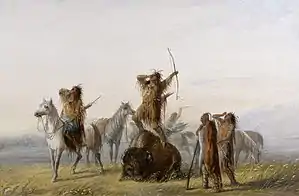Coup de grâce
A coup de grâce (/ˌkuː də ˈɡrɑːs/; French: [ku də ɡʁɑs] ⓘ 'blow of mercy') is a death blow to end the suffering of a severely wounded person or animal.[1][2] It may be a mercy killing of mortally wounded civilians or soldiers, friends or enemies, with or without the sufferer's consent. The meaning has extended to refer to the final event that causes a figurative death.[2]

Methods
Examples of coup de grâce include shooting the heart or head (typically the back of the skull) of a wounded, but still living, person during an execution, and humanely killing in war a suffering, mortally wounded soldier for whom medical aid is not available. In pre-firearms eras the wounded were finished with edged or impact weapons to include cutting throats, blows to the head, and thrusts to the heart. Other examples include the officer leading a firing squad administering a coup de grâce to the condemned with a pistol if the first hail of gunfire fails to kill the prisoner; or a kaishakunin who performs a beheading to quickly end a samurai's agony after seppuku.
Modern law
Today, a coup de grâce for wounded soldiers would be a war crime: the laws of war mandate caring for the wounded and prohibit mercy killing.[3]
References
- Editors of the American Heritage Dictionaries, eds. The American Heritage Guide to Contemporary Usage and Style. Houghton Mifflin Harcourt, 2005. ISBN 978-0618604999 p. 119.
- Charles Harrington Elster. The Big Book of Beastly Mispronunciations: The Complete Opinionated Guide for the Careful Speaker. 2nd ed. Houghton Mifflin, 2006. ISBN 978-0618423156 pp. 110–111.
- Blum, Gabriella (2010). "The Laws of War and the "Lesser Evil"". The Yale Journal of International Law. 35 (1). Archived (PDF) from the original on 2022-03-09.
External links
 The dictionary definition of coup de grâce at Wiktionary
The dictionary definition of coup de grâce at Wiktionary